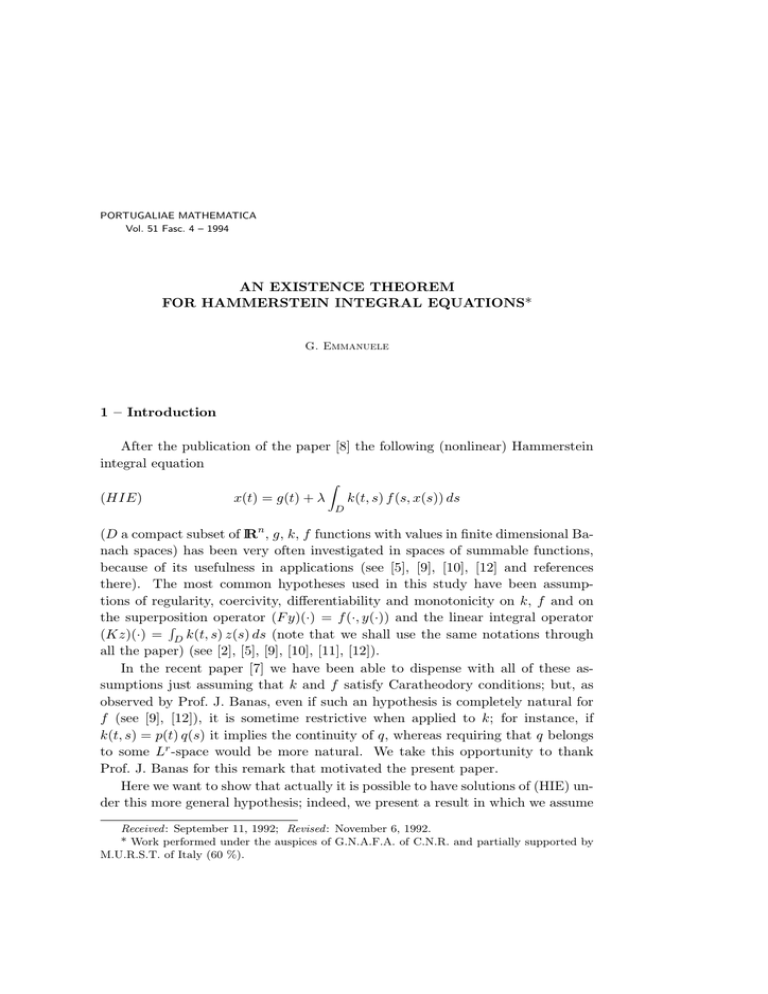AN EXISTENCE THEOREM FOR HAMMERSTEIN INTEGRAL EQUATIONS* 1 – Introduction
advertisement

PORTUGALIAE MATHEMATICA Vol. 51 Fasc. 4 – 1994 AN EXISTENCE THEOREM FOR HAMMERSTEIN INTEGRAL EQUATIONS* G. Emmanuele 1 – Introduction After the publication of the paper [8] the following (nonlinear) Hammerstein integral equation (HIE) x(t) = g(t) + λ Z k(t, s) f (s, x(s)) ds D (D a compact subset of IRn , g, k, f functions with values in finite dimensional Banach spaces) has been very often investigated in spaces of summable functions, because of its usefulness in applications (see [5], [9], [10], [12] and references there). The most common hypotheses used in this study have been assumptions of regularity, coercivity, differentiability and monotonicity on k, f and on the superposition operator (F y)(·) = f (·, y(·)) and the linear integral operator R (Kz)(·) = D k(t, s) z(s) ds (note that we shall use the same notations through all the paper) (see [2], [5], [9], [10], [11], [12]). In the recent paper [7] we have been able to dispense with all of these assumptions just assuming that k and f satisfy Caratheodory conditions; but, as observed by Prof. J. Banas, even if such an hypothesis is completely natural for f (see [9], [12]), it is sometime restrictive when applied to k; for instance, if k(t, s) = p(t) q(s) it implies the continuity of q, whereas requiring that q belongs to some Lr -space would be more natural. We take this opportunity to thank Prof. J. Banas for this remark that motivated the present paper. Here we want to show that actually it is possible to have solutions of (HIE) under this more general hypothesis; indeed, we present a result in which we assume Received : September 11, 1992; Revised : November 6, 1992. * Work performed under the auspices of G.N.A.F.A. of C.N.R. and partially supported by M.U.R.S.T. of Italy (60 %). 608 G. EMMANUELE that f is a Caratheodory function such that F maps L1 (D, X) into L1 (D, Y ), continuously, and k is a measurable function such that the functions s → k(t, s) belong to L∞ and K is a linear, continuous operator from L1 (D, Y ) into L1 (D, X), where X, Y are finite dimensional Banach spaces (in the sequel, kKk will denote the operator norm of K). 2 – Main result The main tools in the proof of our Theorem below are the following measures of weak noncompactness and of nonequiabsolute continuity introduced by F.S. De Blasi in [4] and by J. Appell and E. De Pascale in [1], respectively. Definition 1 ([9]). Let H be a bounded subset of a Banach space B. We call measure of weak noncompactness of H the number n β(H) = inf ε > 0 : there is a weakly compact set C s.t. H ⊂ C + εB1 o (B1 the unit ball of B). β has the following useful properties (see [4] for a proof): i) β(H) = 0 if and only if H is relatively weakly compact; ii) β(H1 ) ≤ β(H2 ) if H1 ⊆ H2 ; iii) β(H) = β(co(H)); iv) β(rH) = |r| β(H), r ∈ IR; v) If (Hn ) is a decreasing sequence of nonempty, bounded, closed and convex T subsets of B with β(Hn ) → 0, then H = Hn is nonempty (obviously, it is closed, convex and relatively weakly compact by i) and ii)). Definition 2 ([1]). Let H be a bounded subset of L1 (D, X), X a Banach space. We call measure of nonequiabsolute continuity of H the number ½ π1 (H) = lim sup sup δ→0 nZ D0 o kx(t)k dt : m(D0 ) < δ : x ∈ H ¾ . As in [1], p. 150, we can prove the following result. Proposition 1. Let X be a finite dimensional Banach space and H be a bounded subset of L1 (D, X). Then β(H) = π1 (H). AN EXISTENCE THEOREM FOR HAMMERSTEIN INTEGRAL EQUATIONS 609 We are now ready to show our result improving the main Theorem of [7] (where A is the operator defined by putting A(x) = g + λ KF (x)). Theorem. Let X, Y be finite dimensional Banach spaces. We consider the following hypotheses : a) g ∈ L1 (D, X); b) f : D × X → Y verifies Caratheodory hypotheses, i.e. f is strongly measurable with respect to t ∈ D, for all x ∈ X, and continuous with respect to x ∈ X, for almost all t ∈ D; c) there are a ∈ L1 (D) and b ≥ 0 such that kf (t, x)k ≤ a(t) + bkxk , t ∈ D, x ∈ X ; d) k : D × D → L(Y, X) (the space of bounded linear operators from Y into X) is strongly measurable and the linear operator K defined in the introduction maps L1 (D, Y ) into L1 (D, X) continuously; e) The functions s → k(t, s) are in L∞ (D, L(Y, X)) for almost all t ∈ D; f ) |λ| bkKk < 1. Then the equation (HIE) has at least a solution x ∈ L1 (D, X). Proof: Let us put s = (kgk + |λ| kKk kak)/(1 − |λ| bkKk). If Bs denotes the ball of L1 (D, X) centered at θ with radius s, it is very easy to see that A maps Bs into itself, continuously. Now, we observe that for all D0 ⊆ D we have Z kF y(t)k dt ≤ D0 Z a(t) dt + b D0 Z ky(t)k dt D0 from which it follows very easily that (1) π1 (F H) ≤ b π1 (H) for any bounded subset H of L1 (D, X); on the other hand, for any bounded susbset Z of L1 (D, Y ) we have β(KZ) ≤ kKk β(Z), because of the linearity and continuity of K. Using Proposition 1 we see very easily that β(AH) ≤ |λ| bkKk β(H) for any bounded subset H of L1 (D, E) where A is not necessarily compact. 610 G. EMMANUELE Moreover, we recall that h = |λ| bkKk < 1 by virtue of f). Now, define Y1 = Bs , Yn+1 = co AYn for n ∈ IN. It is easy to see that (Yn ) verifies all of the T assumptions in v) because h < 1, and so Y = Yn is a nonempty, closed, convex, relatively weakly compact subset of L1 (D, Y ) that is easily seen to be invariant under A. So it remains only to prove that AY is relatively compact, in such a way that an application of Schauder fixed point Theorem concludes the proof. Let (yn ) be a sequence in Y ; Proposition 1 and (1) give that (F yn ) has a weak converging subsequence (F yh(n) ) in L1 (D, Y ). Since, by virtue of e) the operator R z → D k(t, s) z(s) ds for almost all t ∈ D is weakly continuous on L1 (D, Y ), we obtain that (KF yh(n) ) and so (Ayh(n) ) is pointwise converging, for almost all t ∈ D. On the other hand, AY is equiabsolutely continuous in L1 (D, X) since AY ⊆ Y ; hence it is enough to apply Vitali convergence Theorem (see [6]) to prove that (Ayh(n) ) must be strongly converging in L1 (D, X). We are done. At the end, we observe that if one assumes the existence of a third function h verifying assumptions similar to b) and c), it is possible to prove the existence of solutions of the following more general functional-integral equation ³ x(t) = h t, λ Z k(t, s) f (s, x(s)) ds D ´ recently considered in [3] and [7]. REFERENCES [1] Appell, J. and De Pascale, E. – Su alcuni parametri connessi con la misura di non compattezza di Hausdorff in spazi di funzioni misurabili, Boll. Un. Mat. Ital., B(6) 3 (1984), 497–515. [2] Banas, J. – Integrable solutions of Hammerstein and Uryshon integral equations, J. Austral. Math. Soc., (A) 46 (1989), 61–68. [3] Banas, J. and Knap, Z. – Integrable solutions of a functional-integral equation, Revista Mat. de la Univ. Complutense de Madrid, 2(1) (1989), 31–38. [4] De Blasi, F.S. – On a property of the unit sphere in a Banach space, Bull. Math. Soc. Sci. Math. R.S. Roumanie, 21 (1977), 259–262. [5] Deimling, K. – Nonlinear Functional Analysis, Springer Verlag, 1985. [6] Dunford, N. and Schwartz, J.T. – Linear Operators, Part I, Interscience, 1958. [7] Emmanuele, G. – Integrable solutions of a functional-integral equation, J. Integral Equat. Appl., 4(1) (1992), 89–94. [8] Hammerstein, A. – Nichtlineare Integralgleichungen nebst Anwendungen, Acta Math., 54 (1930), 117–176. [9] Krasnosel’skii, M.A., Zabreiko, P.P., Pustyl’nik, J.I. and Soboleskii, P.J. – Integral Operators in space of summable functions, Noordhoff, 1976. AN EXISTENCE THEOREM FOR HAMMERSTEIN INTEGRAL EQUATIONS 611 [10] Martin, R.H. – Nonlinear operators and differential equations in Banach spaces, Wiley & Sons, 1976. [11] Sobolev, A.V. and Sobolev, V.I. – Differentiability of the Hammerstein operator and solubility of a nonlinear Hammerstein equations, Soviet Math., 34 (1990), 67–77. [12] Zabreiko, P.P., Koshelev, A.I., Krasnosel’skii, M.A., Mikhlin, S.G., Rakovshchik, L.S. and Stecenko, V.J. – Integral Equations, Noordhoff, 1975. G. Emmanuele, Department of Mathematics, University of Catania Viale A. Doria, 6, 95125 Catania – ITALY


